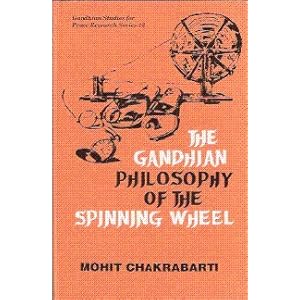
School is keeping me busy. I'd forgotten how much time and effort is involved to study and participate effectively, even for a single class.
In addition, I was asked to take over a Relax and Renew yoga class. Although I've practised yoga for years and taught for a long time, I've never taught a yoga class. I wasn't tapped for my brilliant asanas and instructional skills. I was the only one available to teach this class and I was looking for a way to thank the studio for all it's given me. So, in I leaped.
My experiences have me thinking: how did I get here? At what point did yoga, meditation and fibre arts become my life? How on earth did I decide to combine my spinning with meditation practice? Why do this?
If the combination of sitting and string seems "weird" (as some so straightforwardly put it), the idea of combining the mundane with the spiritual has a long tradition, from spinning for magic and ceremonial purposes down to "The Man" himself - Mohandas K. Gandhi.
Even non-spinners know the association between Gandhi and the spinning wheel, especially the charkha. Lesser known is the philosophy which led to Gandhi's commitment to the wheel and cotton spinning. There is not a lot of popular literature available on Gandhi and spinning, but while I was searching for references to Gandhi and karmayoga (loosely meaning "yoga through action"), I came across a reference to a gem of a book, the cover of which is pictured above. (I have no idea why the image insists on separating itself from the body of my post. Sometimes the mysterious ways of the cyberworld defeat me.)
The book is apparently unavailable for purchase, but I've been able to read excerpts on line. So far, it's the best synthesis I've found of Gandhi's philosophy and his commitment to spinning both as meditation and as a vehicle for the greater good. The author, Mohit Chakrabarti, nicely sums up Gandhi's choice of cotton spinning as symbol and action:
Why does Gandhi take recourse to the spinning wheel when discipline is essentially a training of the mind which can be well-exercised by means of other media of exercise of the mind? The answer, as Gandhi advocates, is quite clear. He is quite aware of the two types of disciplines necessary for the growth and development of being viz., inward and outward. Quite unlike other humanists, Gandhi launches his programme for introducing the spinning wheel to serve the twin purposes of inward discipline while undergoing outer discipline or discipline in the extrinsic form at the same time. (p. 11)So there you have it: spinning, with its steady rhythm and repetitive movement is a means to draw us inward. In the process, we make a product which can be used practically and symbolically. In Gandhi's case, cotton spinning helped end British colonial rule in India.
Now, I don't have such lofty goals, nor do I fancy myself walking in Gandhi's footsteps. The thing is, Gandhi was not "Mahatma" until others made him so. Gandhi was no more or less that human, with all the faults and contradictions attached to the human condition. Sometimes quick to anger, he was by his own admission, often unkind, especially to his wife. Gandhi was a product of his time and culture, as are we all. Yet he found a way to transcend his faults. He used simple means to change his world, inch by inch, thread by thread, with a constant return to mindfulness and right practice.
Gandhi's devotion to spinning and the changes he effected is a practice worth exploring. I'd like to go there for a while and see if I can apply some of Gandhi's ideas and actions to my life.
Let's go higher and see where we land.
Namaste.

My experience is all classes expand to fill the time available---I always think one will leave me with more time than two but it doesn't seem to happen. Exciting opportunities! Abe Books seems to have a couple of sources for the book if you are interested.
ReplyDeletehttp://www.abebooks.com/servlet/SearchResults?kn=mohit&tn=spinning+wheel&x=0&y=0